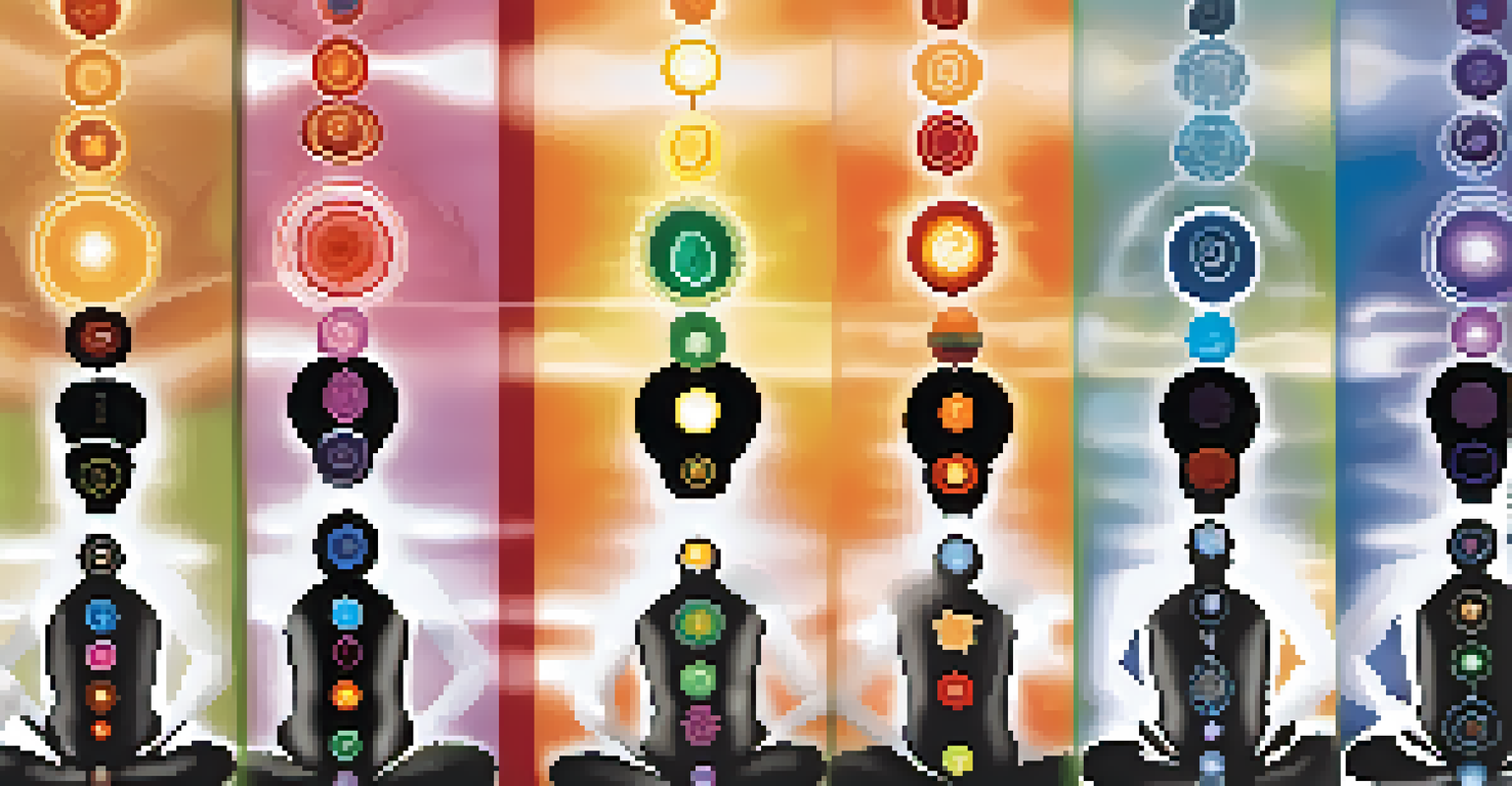Exploring the Seven Chakras: A Comprehensive Overview

What Are Chakras? Understanding the Basics
Chakras are energy centers in the body that influence our physical, emotional, and spiritual well-being. The term 'chakra' comes from the Sanskrit word for 'wheel,' reflecting the idea that these energy centers are constantly spinning. There are seven main chakras, each associated with different aspects of our lives and health. By understanding these energy points, we can better navigate our personal and spiritual journeys.
The body is a sacred garment.
Think of chakras as gateways through which life energy, or 'prana,' flows. When they are open and balanced, we feel vibrant and healthy; when they are blocked or misaligned, we may experience physical or emotional difficulties. This concept of energy flow can be likened to how water moves through pipes—if there's a blockage, the entire system is affected. Understanding chakras encourages us to explore our inner selves and restore harmony.
Incorporating chakra work into your life can be as simple as practicing mindfulness or engaging in yoga. These practices help to align and open the chakras, promoting overall well-being. Whether you’re new to the concept or have been practicing for years, embracing the chakras can lead to profound personal growth and healing.
The Root Chakra: Grounding and Stability
The root chakra, or Muladhara, is located at the base of the spine and is associated with our sense of safety and security. It represents our foundation and is crucial for feeling grounded and stable in life. When this chakra is balanced, we feel secure and confident, ready to tackle challenges head-on. Conversely, an imbalanced root chakra may lead to feelings of fear or instability.

Imagine standing on a solid foundation—this is what a balanced root chakra feels like. Activities such as walking in nature, practicing yoga, or engaging in meditation focused on the root chakra can help to strengthen this energy center. Visualizing a red light at the base of your spine can also promote grounding and security.
Chakras Influence Well-Being
Chakras are energy centers that affect our physical, emotional, and spiritual health, and understanding them can lead to profound personal growth.
Maintaining a healthy root chakra is essential for overall well-being. When we nurture this energy center, we build resilience and a sense of belonging, allowing us to navigate life’s ups and downs with greater ease.
The Sacral Chakra: Creativity and Emotion
Located just below the navel, the sacral chakra, or Svadhisthana, is the center of our creativity and emotional expression. It governs our relationships, pleasure, and the ability to embrace change. When this chakra is balanced, we experience joy, creativity, and a healthy connection with our emotions. Conversely, blockages can lead to feelings of guilt, fear of change, or emotional instability.
Your body is the harp of your soul. It is yours to bring forth sweet music from it or confused sounds.
Think of the sacral chakra as a flowing river of creativity and emotional energy. Engaging in artistic activities, dancing, or simply allowing yourself to express your feelings can help to open this chakra. Additionally, practicing self-care and nurturing your desires fosters a positive connection with this energy center.
By embracing the sacral chakra, we can enhance our creativity and emotional intelligence. A balanced sacral chakra encourages us to flow with life, adapt to changes, and express our true selves without hesitation.
The Solar Plexus Chakra: Personal Power
The solar plexus chakra, or Manipura, is located in the upper abdomen and serves as the center of personal power and self-esteem. This energy center influences our confidence, willpower, and motivation. When balanced, it empowers us to take action and pursue our goals with determination. However, an imbalanced solar plexus chakra can result in feelings of powerlessness or low self-worth.
Visualize the solar plexus chakra as a vibrant yellow sun radiating warmth and confidence. Activities that promote self-acceptance, such as affirmations or setting boundaries, can help strengthen this chakra. Engaging in physical activities, like martial arts or running, also builds confidence and personal power.
Balanced Chakras Promote Harmony
When chakras are open and balanced, they allow for a smooth flow of energy, resulting in feelings of stability, creativity, personal power, and love.
Harnessing the energy of the solar plexus chakra allows us to step into our personal power. By nurturing this chakra, we cultivate self-confidence and the courage to pursue our dreams, leading to a more fulfilling life.
The Heart Chakra: Love and Compassion
The heart chakra, or Anahata, is located in the center of the chest and represents love, compassion, and connection. This powerful energy center bridges our physical and spiritual selves, allowing us to give and receive love freely. When balanced, the heart chakra opens us up to empathy and deep emotional connections. In contrast, blockages can lead to feelings of loneliness, resentment, or emotional detachment.
Think of the heart chakra as a warm, green light radiating love and compassion. Engaging in acts of kindness, practicing gratitude, and nurturing relationships can help to open this chakra. Meditation focused on love and compassion can also create space for healing and emotional balance.
By cultivating the energy of the heart chakra, we enhance our ability to love ourselves and others. A balanced heart chakra fosters meaningful connections, enriching our lives and allowing us to experience the world with an open heart.
The Throat Chakra: Communication and Expression
Located at the throat, the throat chakra, or Vishuddha, governs our communication and self-expression. This chakra plays a crucial role in how we express our thoughts and feelings, influencing our ability to articulate our truth. When balanced, we communicate clearly and confidently. However, an imbalanced throat chakra can lead to difficulties in expressing oneself or fear of speaking out.
Imagine the throat chakra as a clear blue sky, symbolizing open communication. Engaging in practices such as journaling, singing, or speaking your truth can help to clear blockages. Additionally, mindful listening fosters better communication with others, creating a healthy dialogue.
Practices to Align Chakras
Engaging in mindfulness, yoga, and other self-care practices can help align and open the chakras, enhancing overall well-being.
Nurturing the throat chakra enhances our ability to express ourselves authentically. A balanced throat chakra empowers us to share our ideas, fostering deeper connections and understanding in our relationships.
The Third Eye Chakra: Intuition and Insight
The third eye chakra, or Ajna, is located between the eyebrows and is associated with intuition, insight, and perception. This energy center helps us connect with our inner wisdom and the world around us. When balanced, the third eye chakra enhances our ability to see beyond the surface, allowing us to tap into our intuition. Conversely, blockages can lead to confusion, lack of clarity, or difficulty trusting our instincts.
Think of the third eye chakra as a guiding light illuminating your path. Practices like meditation, mindfulness, and visualization can help to strengthen this chakra. Taking time to reflect and listen to your inner voice nurtures this energy center, fostering clarity and insight.

By embracing the wisdom of the third eye chakra, we cultivate a deeper understanding of ourselves and our surroundings. A balanced third eye chakra allows us to navigate life with clarity, intuition, and purpose.
The Crown Chakra: Spiritual Connection
The crown chakra, or Sahasrara, is located at the top of the head and represents our connection to spirituality and higher consciousness. This energy center connects us to the universe and the greater whole. When balanced, the crown chakra fosters feelings of peace, unity, and spiritual enlightenment. However, an imbalanced crown chakra can lead to feelings of disconnection or spiritual confusion.
Visualize the crown chakra as a radiant violet light, symbolizing spiritual awareness. Engaging in practices such as meditation, prayer, or spending time in nature can help to open this chakra. Connecting with others who share your spiritual interests can also deepen your understanding and connection.
Nurturing the crown chakra allows us to align with our higher selves and the universe. A balanced crown chakra fosters spiritual growth and a sense of belonging to a greater purpose, enriching our lives profoundly.